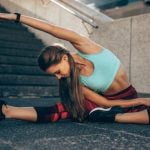How are workout leggings supposed to fit? Finding the perfect fit in workout leggings is essential for both comfort and performance during your exercise routine. The right fit ensures that you can move freely without any restrictions while providing the necessary support for your muscles.
When it comes to workout leggings, proper fit plays a crucial role in enhancing your overall workout experience. Ill-fitting leggings can lead to discomfort, chafing, slipping down, or even hindering your performance. Understanding how workout leggings are supposed to fit can make a significant difference in how you feel during your workouts.
From measurement guides to different types of leggings such as compression or non-compression styles, there are various factors to consider when finding the right fit for your workout leggings. Stay tuned as we delve into the importance of proper fit, ways to measure for the perfect size, and tips on testing the fit before making a purchase.
Understanding the Different Types of Workout Leggings
Workout leggings come in a variety of types, each designed to cater to different exercise routines and preferences. One popular type is the high-waisted leggings, which provide extra coverage and support around the midsection.
These are great for activities like yoga or pilates where you need a secure fit to keep your leggings in place as you move through different poses. On the other hand, low-rise leggings sit below the natural waistline and offer a more relaxed fit, making them ideal for cardio workouts or weightlifting where you need more freedom of movement.
Another common type of workout leggings is the seamless style, which eliminates any seams along the sides or waistband. This design not only provides a smooth silhouette but also reduces the risk of chafing during high-intensity workouts. Seamless leggings are often made with stretchy, moisture-wicking fabric that hugs your body without feeling restrictive. Additionally, compression leggings are popular among athletes because they help improve blood circulation and reduce muscle fatigue during intense training sessions.
When choosing workout leggings, consider the type of exercise you’ll be doing and what features are most important to you in terms of fit and comfort. Whether you prefer high-waisted or low-rise, seamless or compression, finding the right type of workout leggings can enhance your performance and boost your confidence at the gym. Remember that it’s crucial to try on different styles and sizes to determine how they should fit your body shape and movement patterns.
| Types of Workout Leggings | Features |
|---|---|
| High-Waisted Leggings | Extra coverage and support around the midsection |
| Low-Rise Leggings | Sit below natural waistline for more relaxed fit |
| Seamless Leggings | No seams for smooth silhouette and reduced chafing |
| Compression Leggings | Improves blood circulation and reduces muscle fatigue |
Finding Your Perfect Size
When it comes to workout leggings, finding the perfect size is crucial for ensuring optimal performance and comfort during your workouts. Ill-fitting leggings can not only hinder your movement but also lead to discomfort and potential chafing. So, how are workout leggings supposed to fit? Here’s a guide to help you determine the right size for your body.
To accurately find your perfect size in workout leggings, it’s essential to take proper measurements of your body. Start by measuring your waist, hips, and inseam. Use a soft measuring tape for more accurate results. Once you have these measurements, refer to the brand’s size chart to find the corresponding size for each measurement. Keep in mind that sizes can vary between brands, so it’s always best to consult the specific brand’s size guide.
In addition to taking measurements, consider any unique features of your body that may affect the fit of workout leggings. For example, if you have a smaller waist and wider hips, you may need to choose a size that accommodates both measurements.
Similarly, if you are taller or shorter than average, you may need to look for brands that offer different length options for leggings. Remember that the goal is to find leggings that provide a snug fit without being too tight or restrictive on any part of your body.
- Measure your waist at its narrowest point
- Measure your hips at their widest point
- Measure your inseam from crotch to ankle
- Consult brand-specific size charts
- Consider unique body features for optimal fit
The Ideal Length for Workout Leggings
When it comes to choosing the ideal length for workout leggings, one of the key considerations is personal preference. Some individuals prefer the shorter, more breathable design of Capri leggings, while others opt for the full-length style for added coverage and warmth. Both options have their own unique benefits and appeal depending on the activities you plan to engage in.
Capri Leggings
Capri leggings typically end around mid-calf or just below the knee, offering a more lightweight and versatile option for workouts. These are perfect for warmer weather or high-intensity activities where breathability is key. Additionally, Capri leggings tend to provide more freedom of movement and flexibility compared to full-length leggings.
Full-Length Leggings
On the other hand, full-length leggings extend all the way down to your ankles, providing additional coverage and support. These are ideal for colder weather or activities that require more protection from the elements. Full-length leggings also offer compression benefits that can help improve circulation and reduce muscle fatigue during workouts.
Ultimately, when deciding between Capri and full-length workout leggings, consider your personal style preferences, the type of activities you will be doing, and how much coverage and support you need. It’s important to choose a length that not only fits well but also makes you feel comfortable and confident during your workouts.
Compression vs Non-Compression Leggings
When it comes to workout leggings, one major consideration is whether to opt for compression or non-compression styles. Compression leggings are designed to fit tightly around the legs, offering support and increased blood flow during exercise. On the other hand, non-compression leggings have a more relaxed fit, ideal for low-impact activities or casual wear.
So, how are workout leggings supposed to fit? The answer largely depends on your personal preferences and the type of workout you will be engaging in.
For those who engage in high-intensity workouts or running, compression leggings can provide added stability and muscle support. The snug fit of compression leggings can help reduce muscle fatigue and enhance performance during activities that involve repetitive movements. On the other hand, if you prefer a more relaxed feel during your workouts or if you will be doing yoga or Pilates, non-compression leggings may be the better choice for you.
It’s essential to consider not only the type of workout you’ll be doing but also how you want your workout leggings to fit. Some individuals may find compression leggings too constricting or uncomfortable, while others appreciate the supportive feel they provide. Ultimately, choosing between compression and non-compression leggings comes down to personal preference and what makes you feel most comfortable during your fitness routine.
| Compression Leggings | Non-Compression Leggings |
|---|---|
| Provide muscle support | More relaxed fit |
| Increase blood flow | Ideal for low-impact activities |
| Reduce muscle fatigue | Suitable for casual wear |
The Role of Fabric in the Fit of Workout Leggings
When it comes to finding the perfect fit in workout leggings, the type of fabric plays a crucial role. The fabric not only determines the comfort level of the leggings but also affects their overall fit and performance during workouts. Different fabrics have different stretch capabilities, moisture-wicking properties, and compression levels. It is essential to choose a fabric that suits your workout needs and preferences.
Choosing the Right Fabric for Your Workout Leggings
One of the most popular fabrics used in workout leggings is spandex or elastane, known for its exceptional stretch and flexibility. Spandex provides a snug fit that moves with your body during intense workouts, offering support and freedom of movement. Additionally, moisture-wicking fabrics like polyester blends are ideal for intense sweat sessions as they help draw moisture away from the skin, keeping you dry and comfortable throughout your workout.
Fabric Compression Levels and Support
Another important aspect to consider when selecting workout leggings is the level of compression provided by the fabric. Compression leggings are designed to offer support to muscles, improve blood circulation, and reduce muscle fatigue during workouts. Fabrics with higher compression levels are beneficial for activities like running or weightlifting.
On the other hand, non-compression leggings provide a more relaxed fit and are suitable for low-impact activities such as yoga or Pilates. Understanding how different fabrics affect compression can help you choose the right pair of workout leggings for your specific needs.
Common Fit Issues and How to Fix Them
When it comes to workout leggings, finding the perfect fit is essential for both comfort and performance. Ill-fitting leggings can not only be uncomfortable during your workout but can also lead to chafing, slipping, or even restricting your movement. So, how are workout leggings supposed to fit? Here are some common fit issues that you may encounter and how to fix them:
1. Rolling Waistband: One of the most common fit issues with leggings is a rolling waistband. This can be frustrating during a workout when you constantly have to adjust your leggings. To fix this issue, make sure you are wearing the right size leggings. If the waistband still rolls, try opting for high-waisted leggings that provide more coverage and support.
2. Sagging Crotch: Another fit issue that many people face is sagging in the crotch area of their leggings. This can be caused by wearing leggings that are too big or by fabrics with poor elasticity. To fix this problem, choose leggings with a gusseted crotch design for better shape retention and flexibility.
3. Sheer Fabric: If you notice that your leggings become see-through during certain movements or positions, it may be due to the fabric being too thin or stretched out. To avoid this issue, always opt for squat-proof fabrics like nylon-spandex blends and make sure you are wearing the correct size legging for optimal coverage.
By addressing these common fit issues in your workout leggings, you can ensure a more comfortable and effective workout experience. Remember that finding the right fit involves more than just choosing the correct size – consider factors like fabric, design features, and intended use for the best results in your fitness routine.
Tips for Testing the Fit of Workout Leggings Before Buying
When it comes to finding the perfect pair of workout leggings, ensuring the right fit is essential for both comfort and performance. But with so many options available on the market, it can be challenging to know how to choose the right one. Before making a purchase, there are a few key tips for testing the fit of workout leggings to make sure they are just right.
First and foremost, when trying on workout leggings, pay attention to how they feel around your waist. The waistband should sit comfortably without digging in or rolling down during movement. It should also provide adequate support without feeling too tight or restrictive. Additionally, make sure the leggings stay in place during various exercises like squats or running to prevent any unwanted adjustments.
Another important aspect to consider when testing the fit of workout leggings is the overall shape and contouring of the garment on your body. The leggings should have a snug but not skin-tight fit that allows for freedom of movement without excess fabric bunching up or sagging in certain areas. Look for a style that accentuates your body while still providing enough coverage and support for your activities.
How to Care for Your Workout Leggings to Maintain a Perfect Fit
When it comes to workout leggings, achieving the perfect fit is essential not only for comfort but also for performance. Understanding how workout leggings are supposed to fit can make a significant difference in your overall exercise experience. Properly fitting leggings should feel snug but not constricting, with no sagging or sliding down during movement. The waistband should sit comfortably at your natural waist or hips, depending on your preference.
Different types of workout leggings cater to varying needs and activities, whether you opt for compression or non-compression styles. Knowing your measurements and finding the right size is crucial in ensuring a proper fit. Some brands may run smaller or larger than others, so don’t hesitate to refer to the specific sizing charts provided by manufacturers before making a purchase.
In addition to selecting the right size and type of leggings, paying attention to the fabric composition is equally important. Moisture-wicking materials like Nylon-Spandex blends are ideal for wicking away sweat during intense workouts, while cotton blends are better suited for low-impact activities. By following these guidelines on fit, size, type, and fabric selection, you can maintain a perfect fit in your workout leggings and enhance your performance during any physical activity.
Frequently Asked Questions
Are Workout Leggings Supposed to Be Tight?
Workout leggings are designed to be snug and form-fitting in order to provide support and flexibility during exercise. A tight fit helps prevent chafing, allows for maximum range of motion, and can enhance muscle compression for improved performance.
How Do I Know if My Gym Leggings Fit?
To determine if your gym leggings fit correctly, there are a few key indicators to consider. The waistband should stay in place without rolling or sliding down during movement. The fabric should feel comfortable and supportive, not too loose or restrictive. Additionally, check for any sagging or excess fabric around the knees, hips, or crotch area.
Should I Size Up or Down in Gym Leggings?
When deciding whether to size up or down in gym leggings, it ultimately depends on personal preference and body type. If the leggings feel too tight, restricting movement or causing discomfort, sizing up may be necessary for a more comfortable fit.
Conversely, if there is excess fabric bunching up or sagging in certain areas, sizing down could provide a more snug and supportive fit for workouts. It’s essential to consider how you want the leggings to feel during physical activity – whether you prefer a tighter compression fit or a slightly looser feel for breathability and flexibility.

Passionate about providing useful information to anyone with an interest in the field of Personal Training, I strive to pass on to our readers quality information and to answer any questions about Personal Trainers, the work they do and how to become one.





